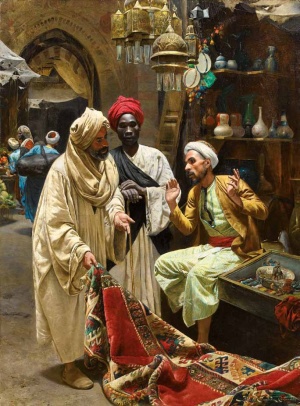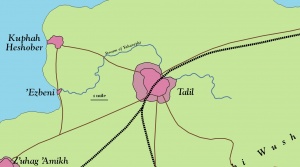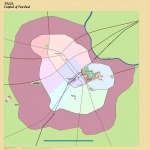Featured Article
|
 The Narsadese Capital of Talil is famous for its merchants Talil is the historic and modern capital of Narshad. The name Talil is thought to come from an ancient Cospian word that means 'for the god.' Talil rests on a slight prominence north of the Th'abi Wushal Hills and south of the Stream of Yaharaphi that flows into the sea. Talil rests about 5.5 mi (9km) from the seashore where it was historically safer from direct piracy. Its access to the sea is provided through the small city of Kuphah Heshober. In ancient times during some Narshadite dynasties, Talil was the royal seat. Today, Talil is the seat of the Shu'ah, the sovereign legislative body of the Narsadese Republic and meets regularly in the Jehimzalya Palace. The population of Talil proper is estimated at 232,000 and is the twenty second largest in the old world. The demonym is Talilite. The city of Talil has vied with Syre for thousands of years to be the most important on the island of Narshad.
 Map of Talil and Environs Talil is administered by a mayor governor who presides over the city council which is composed of local representatives elected by the leading families of each of the eleven districts of the city. The eleven districts are: Jahshimuz' District, Ebinóëse District (Talil), Cospian District (Talil), Shelekhumbian District (Talil, Tis'bajuma District (Talil), Commercial District (Talil), Jerushablan District (Talil), Merchants District (Talil), Halakhan District (Talil), Iymajbun District (Talil), Bisrajin District (Talil).
Talil is served by dragonrail through Qakhi Dragonrail Station and modern Khaliymith Skyport. (Full Article...)
|
Did you know...
|
- Did you know that Orkybanthius of Zander, a cosmologer of the fourth century developed a theory to explain and account for the existence of giants?
- Did you know that the mythical Asurrhá are said to be the truly rare offspring of the union of an Isxinthion god and an Elamahti?
|
|
|
Featured Pictures
|
The Aio
Before an invasion of the Communions or the Throes, an aio may arrive and seek out the greatest enemies of Chaos — to present himself as an unquestioning servant with the hidden aim of corrupting his new master, or more often, mistress. An aio appears as a powerfully strong man, completely bald with irises of orange-red. The voice, manner, and appearance of an aio are thoroughly handsome and soothing—and they often seek to seduce women of high station and influence. Like their masters, the communions, the aio are averse to clothing—they wear but one type of vestment only to fulfill their ends—and such vestments are dazzlingly beautiful and enchanted. Such a vestment is called a jisseen — it appears as many garments, but in fact is one intricately fabricated piece that wields powerful magics on those who glimpse it and also serves as magical armor to an aio. (Full Article...)
 A courtyard in one of the glittering palaces of Medibgö Portal:Medibgö
The Medibgö Portal, although just a stub, now has a sizable collection of links to topics related to the culture and Empire of Medibgö. (Full Article...)
|
Recommended Articles
These articles are recommended for gaining a better understanding of the history and background of the world of Asdar.
|
|
|




